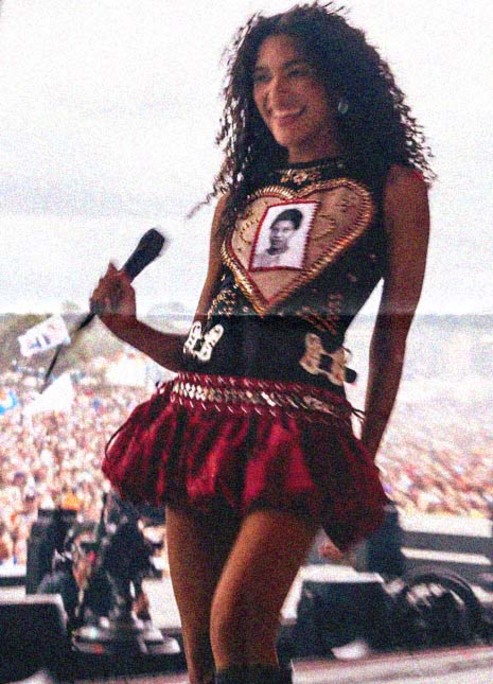
Of Course The Bandage Dress Is Back, Look At The Year We’re Having
In a year obsessed with control, the bodycon’s grip makes absolute sense.
In fashion, what is old is always new again. Enter the bandage dress, a club-classic sensation that is back with a bang, and that, according to Aricia Symes, author of The Style Formula: The Art and Science of What to Wear, feels more like a dare than a dress.
Although Alaïa showed the first bandage dresses on the runway in the 1980s, it was the 90s-era Hervé Léger that cemented its popularity. During the 2000s, celebrities like Lindsay Lohan, Rihanna, Kim Kardashian, and Emma Watson made the bandage dress a bona fide icon. Now, it's having a big revival after influencer Hailey Bieber and model Kaia Gerber have been seen wearing them.
Why now?

Re-emerging in the wake of minimalistic aesthetics’ boom, the bandage dress is seen by many as a bold response to those more quiet trends. Others, however, believe that its comeback stems from Gen Z’s fascination with nostalgia — the same driving force behind the revival of countless past trends, including the sleek, effortlessly cool minimalism of the ‘90s. But are those really the only reasons for the bandage dress return? Or is the timing more telling?
Naturally, as Saige Thomas, co-founder of Texas Fashion Week, points out, the resurgence of the garment isn’t surprising since fashion’s nature is cyclical. Still, since fashion is a means of expression that captures the cultural zeitgeist, the resurgence of trends is anything but random.
And the bandage dress it’s no exception. As explained by Peter Martinez, co-founder and fashion stylist at Leather Skin Shop, the garment’s return aligns not only with nostalgia, but also with body culture and economic gloom.
In light of the increased use of medications such as Ozempic for weight loss, mounting societal pressures surrounding body image, economic uncertainty, and the rise of far-right governments, the stylist believes that fashion is responding not with rebellion, but with restriction.
The controversies surrounding the bandage dress

Once synonymous with the early-2000s hypersexual glamour, the bandage dress carries lots of cultural baggage. Skin-tight, body-conscious, and unapologetically sculpted, it became a symbol of an era steeped in toxic body ideals. “Bodycon styles tend to bring up a flood of internalized messaging and antiquated stereotypes: about femininity, sexuality, class, intelligence, even self-worth,” reflects style expert and author Symes.
And while some might argue that the garment gained popularity because it allowed women to confidently flaunt their curves, looking back, its heyday moments only existed on one type of body: thin yet hourglass and ever-cis.
The bandage dress, its unrealistic ideals, and the societal norms surrounding it

Now, even amid fashion’s proclaimed progress toward inclusion and diversity, the bandage dress’ comeback still reveals a beauty standard that continues to privilege one type of body — it's no coincidence that it has just become popular again after being worn by two slim, cisgender women. Julia Pukhalskaia, a fashion stylist and CEO of Mermaid Way, argues that a deep-rooted cultural discomfort still exists around marginalized bodies embracing overtly sexy or form-fitting clothing. ‘‘A size 2 woman in a blush pink bandage dress is referred to as being elegant, but a size 18 woman in the same dress is told to dress for her body,’’ Mermaid Way’s CEO points out.
Additionally, she suggests that this posture is not only directed towards physiques that don't comply with conventional beauty standards, but also towards gender identities that don't conform societal norms. ‘‘My non-binary client once appeared at an event in a bandage dress and combat boots with slicked-back hair. It was a bold glance that combined femme and punk styles, but they were told by others that they looked too provocative,’’ Pukhalskaia recalls.
Owning every curve: the confidence boost of the bandage dress and its chance of being for everyone

Actress and plus-size model Nzinga Imani is well aware of the bandage dress’s exclusive and often oppressive history. Yet, she adores how the dress sculpts her curves and makes her feel utterly fierce.
Personal stylist Amanda Massi sees the bandage dress’ comeback as a chance to champion body positivity, as long as the trend is promoted and adopted inclusively and diversely. Author Aricia Symes shares similar views, explaining that we can redefine what ‘‘sexy’’ means while transforming the bandage dress not into a symbol of an unattainable standard, but as a celebration of owning your space, shape, and story.
Despite efforts to make the fashion industry and bodycon garments more diverse, not everyone is included — especially when initiatives come mainly from the audience rather than the industry. Vogue Business’ size inclusivity report for the Spring/Summer 2025 season shows that only 0.8 percent of the 8,763 looks presented across 208 shows and presentations were plus size (US 14+). Meanwhile, 4.3 percent were mid-size (US 6–12), and 94.9 percent were straight size (US 0–4).
With little to no representation on runways, AI models appearing in ads in Vogue magazine, and the industry’s resistance to creating more spaces where individuals of all sizes and gender identities can comfortably express themselves, it’s naive to think that everyone can wear a bandage dress without facing the same repercussions. As shared by John Smith, the Vice President of Design at Poshele, the bandage dress return signals ‘‘how trends, bodies, and social rules are changing, but not all at the same pace.’’ Ultimately, the garment involves complexities that must be acknowledged and overcome.











